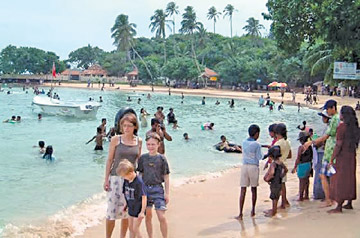
Colombo, April 22 (newsin.asia) — Sri Lanka Tourism plans for an early revival post-COVID-19, as the country starts opening up gradually from this week.
A major step was the Cabinet approval of the critical five-year global promotion initiative last week and plans are underway to finalize the Terms of Reference and appointment of the Procurement, Project and Technical Evaluation Committees; and the process will start when the time is right.
“The approach focuses on consumer types and will allow for research supported global promotional campaign for Sri Lanka and a traveller-focused, evidence-based promotion strategy will be developed” Sri Lanka Tourism Chairperson Kimarli Fernando stated.
Sri Lanka Tourism is also currently working with the United Nations Development Program (UNDP) in a three-stage strategy of situation assessment, impact assessment and road mapping, to help get tourism industry back on its feet.
According to Data, there are 11,071 registered entities and individuals in the industry. Additionally, there are 2,669 accommodation facilities with 39,253 rooms. The industry also comprises of 34 associations including regional associations. In addition to the accommodation sector, there are associations of Travel Agents (DMC’s), Tour Guides and Drivers, inputs from whom are also essential going forward.
“Tourism in Sri Lanka is an industry built on diversity and inclusivity, the input and collaboration of all tourism organisation is critical in the current situation, and would be of great benefit in planning the future. I look to all associations to provide us with their formal proposals to help Sri Lanka Tourism to complete an inclusive long-term strategy,” she said, adding that the Sri Lanka Tourism Alliance industry grouping has already submitted a proposal.
She said despite the uncertainty of the current situation, it is necessary to address day-to-day
matters, whilst maintaining the foresight to plan ahead.
COVID-19 also provides us with an opportunity for Sri Lanka Tourism to re-profile itself when the time is right. “We can realign our focus towards higher-yielding tourists and a unique Sri Lankan experience; while ensuring the safety of travellers, our employees and citizens,” she added.
According to her, the Sri Lanka Tourism’s post-COVID-19 approach takes is in two stages – Stage 1 (December Season 2020) and Stage 2 (Post-December 2020).
Stage 1 focuses on the immediate recovery of the industry, which involves changes to the visa process to include mandatory testing, adjustments to the immigration process, airport entry, hotel transfer and certification of hotels to ensure health and safety of tourists, employees and the local community.
She pointed out that designated quarantine hotels need to be established with staff safety being paramount. With advice from the Ministry of Health, a detailed guideline will be released, and establishments will be audited to ensure compliance.
Rigorous health and safety activities incur costs and as such, it is recommended that a minimum pricing structure be established for accommodation, avoiding undercutting and the resulting race to the bottom.
“In the spirit of global solidarity, we would also recommend an optional rapid test on departure at Sri Lanka Tourism cost, with results to be instantly messaged. This would provide assurance to tourists as they continue their travels elsewhere. When the airport is fully operational, it would be an opportunity to increase flights and
connectivity to Sri Lanka as an emerging transit hub in South Asia. This would be a learning experience from Singapore and Dubai’s example in building their tourism industry,” she added.
Sri Lanka Tourism Chairperson also stressed that the Government and the Central Bank have extended their fullest support to fast track industry recovery.
“We look to the banks and financial institutions to support us and stand by our industry. We are personally contacting banks to assist our industry and currently working on how to support the industry for payment of salaries for the lower brackets and individuals with no safety net, through engagement with international funding agencies.”
She said COVID-19 was a severe blow to the industry which was still recovering after the Easter Sunday attacks last April. She said as the pandemic unfolded, the priority was the safety of tourists in Sri Lanka and on 12 th March when the World Health Organization (WHO) declared COVID-19 a pandemic, there were 76,224 foreign travellers in Sri Lanka.
Immediately, a 24/7 call centre was set up to assist tourists and with transportation issues in times of curfew, outbound flight tickets were allowed to be used as curfew passes to reach the airport. Another issue faced by foreign travellers was accommodation, with many hotels closing.
Alternative accommodation was found in other hotels and hostels and Sri Lanka Tourism liaised with the Foreign Ministry, embassies, airport authorities and airlines to facilitate safe departure.
We also launched “The Tourist and Expatriate Support Centre” website which provides live updates, essential information and assistance to tourists and at present, there are 12,329 tourists in Sri Lanka.
She appreciated the resilience and solidarity within the industry and all stakeholders and said will focus on the rebuilding the tourism industry with their support.
Further, she stated that the Government’s preparedness for this pandemic is commendable and success in mitigating the impact gives Sri Lanka a chance to share the country’s deep-rooted history of wellness with the world.
“As a nation, we have much to offer in terms of our tranquil tourist experiences, Hela Vedakhama, Indigenous Ayurveda, traditional spices, herbs and traditions. Our nation prides itself in its hospitality and focuses on wellbeing. In a post-pandemic world, there will be a greater appreciation for what our nation has to offer. We will soon once again be able to share the beauty of our country with foreign travellers across the globe and welcome them with a warm Ayubowan” Sri Lanka Tourism Chairperson said.
